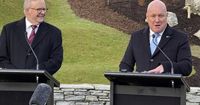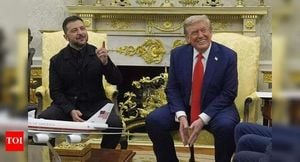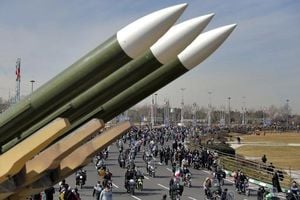On a crisp August weekend in 2025, the snow-capped peaks near Queenstown, New Zealand, set the stage for a meeting that could reshape the security and economic fabric of the South Pacific. Australian Prime Minister Anthony Albanese and New Zealand Prime Minister Christopher Luxon, old colleagues-turned-leaders, gathered for their annual bilateral summit amid what both described as the "most unpredictable and dangerous" strategic environment in decades. But it wasn’t all stern talk and steely gazes—there was laughter, friendly rivalry over the origins of the pavlova dessert, and a shared moment of remembrance at an Anzac memorial in Arrowtown, where both leaders honored their countries’ fallen soldiers, side by side.
Yet, beneath the camaraderie, a sense of urgency pulsed through the discussions. According to reporting by AAP and the Global Times, both leaders acknowledged that rising Chinese military assertiveness in the region—underscored by a rare and provocative Chinese live-fire naval exercise in the Tasman Sea in February—had prompted a recalibration of defense priorities. The exercise, which forced commercial airlines to divert their flights, was seen as a stark demonstration of China’s growing military reach, and neither Canberra nor Wellington took it lightly.
"A big focus for us has been interoperability with Australia. We want to be a force multiplier," Luxon told reporters, as cited by the Associated Press. He didn’t mince words about the stakes: "We want to be one, sort of, essential Anzac force essentially operating within our region." The historical reference to the Australian and New Zealand Army Corps (ANZAC), whose soldiers first fought together over a century ago, was more than symbolic. It signaled a concrete intent to deepen military integration between the two countries in response to what both leaders see as a shifting regional balance.
Luxon, who has steered New Zealand’s foreign policy closer to Australia and its Western allies since his election in 2023, floated the idea of piggy-backing on Australia’s deal to acquire 10 frigates from Japan—a move aimed at boosting interoperability and lowering collective costs for both nations. New Zealand’s upcoming replacement of its naval helicopter fleet is also set to be coordinated with Australia. "We want to make sure that they're as interoperable as possible with the Australians when we go to market," Luxon explained. "We actually want to present joint procurement bids for those things that we can tap on the New Zealand requirements, and as a result, lower the collective cost for each of those individual items for each country."
Australia, for its part, is embarking on its most ambitious defense expansion ever. Japan’s Mitsubishi Heavy Industries will build a fleet of 11 Australian naval frigates under a $6.5 billion contract, while the AUKUS partnership with the US and UK will see Australia acquire eight nuclear-powered submarines at a staggering price tag of up to $245 billion. Albanese, fielding questions about defense spending, was unequivocal: "If people argue that we should increase our defense spending, we are."
Luxon has also signaled a major shift in New Zealand’s defense posture. In April, he announced plans to double defense spending to more than 2% of GDP, up from around 1% over the past two decades—a move he called "a big step up for us." Both leaders, according to ABC, stood by their commitments to reach that 2% threshold, though Luxon hinted he’d like to go even further if possible.
But the summit wasn’t all about armaments and alliances. Economic integration was another headline act. The leaders met with business executives to discuss ways to remove regulatory barriers and "get the barnacles off the boat," as Luxon colorfully put it. Their goal: to streamline operations and boost productivity across both economies, an effort that includes renewing joint standards arrangements and making it easier for companies to operate trans-Tasman.
The backdrop to these efforts, however, is a region fraught with geopolitical tension. While some Australian media, such as AAP, claimed that the summit was dominated by China and Gaza, both leaders took pains to strike a balanced tone. In their joint statement, they referenced China three times, expressing "grave concern about dangerous and provocative behaviour in the South China Sea" and "serious concern about the situation in the East China Sea," but avoided singling out Beijing directly. They also called for the peaceful resolution of Taiwan Strait issues "without the threat or use of force or coercion" and confirmed their opposition to unilateral changes to the status quo.
Luxon described China as a "significant world power and a permanent feature of global affairs," adopting what Global Times called a pragmatic approach: "We have an approach which is about co-operating where we can ... We disagree where we must. We have different systems, different values." Albanese echoed this sentiment, emphasizing the importance of managing China-US competition responsibly and maintaining open channels for dialogue. "Of course, the geostrategic competition, in particular between the great powers, is something that countries like Australia and New Zealand do discuss together and we cooperate politically," Albanese said.
Recent months have seen a flurry of official exchanges between China and both Australia and New Zealand. Albanese visited Beijing in July, reaffirming Australia’s adherence to the one-China policy and expressing a desire for "mutually beneficial cooperation" with China. Luxon made a similar trip to China in June, where he emphasized New Zealand’s commitment to the one-China policy and its willingness to maintain high-level exchanges and strategic communication. Chinese officials responded positively, with Foreign Ministry spokespersons expressing readiness to deepen cooperation and mutual trust with both nations.
Yet, not everyone is convinced that closer Australia-New Zealand military ties are an unalloyed good. Chen Hong, director of the Australian Studies Center at East China Normal University, suggested that while the two countries’ pragmatic approach is welcome, their intention to enhance military cooperation "should be viewed with vigilance." He urged both to act as contributors to regional peace and stability, warning that the costs of confrontation could outweigh the benefits.
University of Otago politics researcher Nicholas Khoo, speaking to AAP, saw the summit as evidence of a "steady build-up" of cooperation that simply didn’t exist until recently. "It's an area where we could legitimately expect to see very real progress," Khoo said, noting that New Zealand now only has one alliance-level partner in Australia, and is investing heavily in that relationship.
For all the talk of military hardware and strategic alliances, the personal rapport between Albanese and Luxon—two leaders from opposite sides of the political spectrum—remained a highlight. Their friendly banter over dessert, their shared history in the aviation sector, and their joint tribute to Anzac soldiers all underscored the deep bonds that tie the two countries together. As Luxon quipped, presenting a pavlova adorned with both kiwifruit and Tim-Tams, "We have solved a centuries-old debate."
In an era of uncertainty, it seems the Australia-New Zealand partnership is leaning in, determined to navigate the choppy waters ahead—together.





